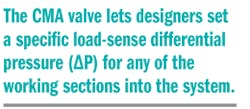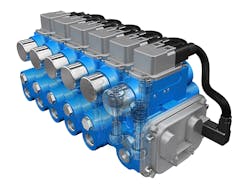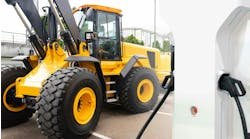Eatonâs CMA valve uses ProFX configuration software to finely tune a wide variety of operating conditions to improve system response and control while simultaneously improving energy efficiency. The valve can be configured in up to eight independent directional-control sections.
Flexible system architecture reduces routing complexity, saves on lengths of hose, and improves weight distribution of components on the vehicle chassis. These come as a result of the CMA valve sets, which allow up to eight multi-sectional and multibank combinations.
Hydraulic system designers can use the CMA valve with most conventional LS pumps, not just those from Eaton. The valve continuously monitors the flow balance, pressure, and temperature of the oil at its inlet port. It also monitors pressure signals from any work port in the system at roughly 700 Hz. Combined with spool response of –100% to +100% within 20 msec, this is fast enough to compensate for pressure spikes by modulating accelerations and decelerations to control the dynamic pressure of the actuators.
The CMA valve can also eliminate up to 70% of oscillation amplitude from harmonic resonance—boom bounce, for example. The residual 30% is typically difficult to detect externally.
An integrator can follow the load-sense pressure or keep the pump at constant pressure and eventually define a torque-limiting curve to prevent bogging down the power takeoff. The control acts through a pressure modulator in the load-sense line back to the pump.
The CMA valve lets designers set a specific load-sense differential pressure (âP) for any of the working sections into the system. The valve can reduce energy consumption by lowering the âP when a function does not need aggressive dynamic response. Conversely, it can provide quicker response when a specific load needs higher acceleration or deceleration when there’s an increase in vehicle speed.
Independent metering on the CMA valve unlocks the mechanical link between the amount of oil sent an actuator and the amount of oil routed back to tank. This capability opens up a wide range of control criteria to achieve simultaneous control of pressure and flow. Such dynamic response and inertial management allows for customized tuning of the load-control response using Eaton’s ProFX configuration software.
An intelligent flow controller embedded in the CMA valve has a tunable algorithm that can alter inertial directional control on the valve’s meter-in line and a dynamic tunable pressure control on its meter-out line. This combination of separately tunable and synchronized controls on the two independent spools enables fine dynamic response tuning and customizable load-feel feedback.
Daniel Galler is a Mechanical Engineer at Eaton’s Hydraulic Group in Northern Italy. For more information, call Eaton Hydraulics at (800) 386-1911, or visit www.eaton.com/hydraulics.





